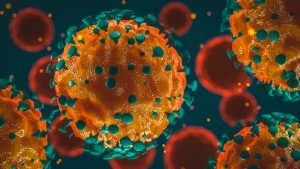This year’s cold and flu season is similar to every other: The latest strain is often different from the previous one. Usually, the difference is small, and that’s how vaccines work. They take last year’s virus and make this year’s vaccine.
Influenza vaccines produced in a particular year are derived from certain proteins found in last year’s virus. The CDC makes a determination about what strain they expect to be dominant in the coming year, and companies base their decisions on those predictions. From a Covid standpoint, that strain is called JN.1. JN.1 is derived from a variant of the famed Omicron Covid strain, although the original Omicron strain no longer exists.
If you have the material from last-year’s Covid or flu viruses, why are vaccines sometimes so ineffective in achieving their purpose? In one recent year, the flu vaccine gave you no more than 19 percent protection against the next year’s virus.
To understand why, let’s talk about two concepts we’ll discuss today: Antigenic Drift and Antigenic Shift.
Antigenic Drift: Viruses are notorious for their ability to mutate, but, fortunately, their mutations rarely make a major change in their genetic makeup. When the changes are so small that the current virus going around is essentially the same as the previous one, it is called antigenic drift. In this circumstance, vaccines are more effective; that is, they reach the surpris0ingly modest CDC goal of 40-60% prevention rate because they are fighting essentially the same virus.
Antigenic Shift: Sometimes, a virus undergoes a major mutation or, alternatively, two viruses combine to make a significant change in the nature of a virus. For example: If the Ebola virus primarily lives in fruit bats in Africa, some mutation along the way made it able to live in human beings. Perhaps another mutation made it more easily transmitted to other humans in bodily secretions. These significant changes in the genetic makeup are called antigenic shifts. With antigenic shifts, all bets are off with regards to predicting the success of a vaccine in preventing disease. To take an even more extreme example, if the Ebola virus mutated to make it easily transmissible via airborne droplets, we’d be in a lot of trouble.
It can be difficult to predict the evolution of the COVID variants, but the Centers for Disease Control and Prevention (CDC) projects that JN.1 cases (currently 44 percent of all new cases) will increase through the winter. The situation is fluid, so much so that another strain, HV.1, was the dominant strain as recently as early December. EG.5 was the dominant strain during the summer.
The good news: So far, JN.1 doesn’t seem to cause more severe cases of COVID than other circulating variants.
One remarkable aspect of JN.1 is its rapid evolution, which suggests it may be better at evading immune systems, or it may simply be more transmissible, according to the Centers for Disease Prevention and Control (CDC). In any case, it’s not to sneeze at.
Protective efforts can help as well. Follow these rules of respiratory “hygiene”:
- Practice good hand hygiene; wash hands thoroughly and often during the day.
- Clean countertops, doorknobs, and other common-area items to reduce the viral load. A dilute bleach solution will work.
- Avoid social situations where someone is sick. Coughs and sneezes can reach others several feet away.
- Sick persons should cover their mouth and nose with tissues or other barrier when coughing or sneezing. Don’t have tissue? Sneeze or cough into your elbow or sleeve.
- Seriously ill individuals should be quarantined in an area away from high-traffic spots in the home. N95 masks, while not considered effective against COVID, can still provide some measure of protection.
Remember that staying indoors is not particularly protective against respiratory infections. The viral load in a closed and crowded room is probably much higher than the air outside!
Joe Alton MD
Hey, don’t forget to check out our entire line of quality medical kits and individual supplies at store.doomandbloom.net. Also, our Book Excellence Award-winning 700-page SURVIVAL MEDICINE HANDBOOK: THE ESSENTIAL GUIDE FOR WHEN HELP IS NOT ON THE WAY is now available in black and white on Amazon and in color and color spiral-bound versions at store.doomandbloom.net.
And don’t forget something entirely different, Dr. Bones and Nurse Amy’s Christmas bedtime story book “Snowbie, The First Snowman,” published by Sky Pony Press!













 Dr. Alton
Dr. Alton











